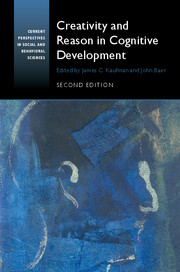Book contents
- Frontmatter
- Dedication
- Contents
- List of Contributors
- Acknowledgments
- 1 Creativity, Reason and Cognitive Development: Ten Years Later
- SECTION ONE CREATIVITY AND REASON IN CHILDHOOD AND THE SCHOOLS
- 2 Creativity in Young Children's Thought
- 3 Early Experiences and Creativity: An Ecological Perspective
- 4 Imaginative Play
- 5 Revisiting the Relationship among Schooling, Learning, and Creativity
- 6 Higher Level Thinking in Gifted Education
- 7 A Young Artist's Story: Advancing Knowledge and the Development of Artistic Talent and Creativity in Children
- SECTION TWO CREATIVITY AND REASON IN COGNITION AND NEUROSCIENCE
- SECTION THREE CREATIVITY AND REASON: INTERACTIONS AND RELATED CONSTRUCTS
- Author Index
- Subject Index
- References
5 - Revisiting the Relationship among Schooling, Learning, and Creativity
from SECTION ONE - CREATIVITY AND REASON IN CHILDHOOD AND THE SCHOOLS
Published online by Cambridge University Press: 05 February 2016
- Frontmatter
- Dedication
- Contents
- List of Contributors
- Acknowledgments
- 1 Creativity, Reason and Cognitive Development: Ten Years Later
- SECTION ONE CREATIVITY AND REASON IN CHILDHOOD AND THE SCHOOLS
- 2 Creativity in Young Children's Thought
- 3 Early Experiences and Creativity: An Ecological Perspective
- 4 Imaginative Play
- 5 Revisiting the Relationship among Schooling, Learning, and Creativity
- 6 Higher Level Thinking in Gifted Education
- 7 A Young Artist's Story: Advancing Knowledge and the Development of Artistic Talent and Creativity in Children
- SECTION TWO CREATIVITY AND REASON IN COGNITION AND NEUROSCIENCE
- SECTION THREE CREATIVITY AND REASON: INTERACTIONS AND RELATED CONSTRUCTS
- Author Index
- Subject Index
- References
Summary
It is the supreme art of the teacher to awaken joy in creative expression and knowledge.
– Albert EinsteinCreativity occupies a tenuous place in schools and classrooms. Scholars have long asserted its value and, at same time, expressed concerns that student and teacher creativity may be undermined in schools and classrooms (Barron, 1969; Guilford, 1950). In recent years, some scholars and commentators have even asserted that creativity is in a state of crisis in schools and classrooms (Berliner, 2011; Kim, 2011), and others have gone as far as to assert that schools kill creativity (Robinson, 2006). We take a more balanced position. We recognize that as long as there is life, there is creativity (Beghetto, 2013), and as such, schools cannot kill it. However, to the extent that formal schooling homogenizes student knowledge and behavior, educators interested in promoting creativity have reason to worry. But does school-based learning necessarily come at the cost of student creativity? The purpose of this chapter is to explore this question.
Creativity, Knowledge, and Formal Schooling
More than fifty years ago, J. P. Guilford recognized that creativity plays a prominent role in learning. And in the years that followed, creativity scholars have amassed persuasive evidence supporting the relationship between learning and creativity. For example, Robert Weisberg (1999) demonstrated that, be it the Beatles, Mozart, Charlie Parker, or Picasso, all experienced extensive, immersive learning processes prior to developing the domain knowledge necessary for producing creative contributions. When it comes to K–12 schools and classrooms there are also examples of how creativity can be incorporated in the learning of academic subject matter and standards-based learning, such as the Common Core State Standards (Beghetto, 2013; Beghetto, Kaufman, & Baer, 2014).
Although there is a general consensus among researchers that a deep level of domain knowledge is necessary for creative expression, the relationship between the type of knowledge sometimes represented in formal school settings and creative contributions is less clear. Sometimes what and how subject matter is taught in K–12 classrooms has little resemblance to the domain knowledge used by professionals and accomplished creators. Educational researchers (e.g., Lave & Wenger, 1991; Shepard, 2001) have, for instance, called for more “authentic” school-based learning, noting a frequent lack of correspondence between school-based representations of knowledge and how participants in a discipline (e.g., scientists, historians, writers) actually represent knowledge.
- Type
- Chapter
- Information
- Creativity and Reason in Cognitive Development , pp. 72 - 91Publisher: Cambridge University PressPrint publication year: 2016
References
- 4
- Cited by



